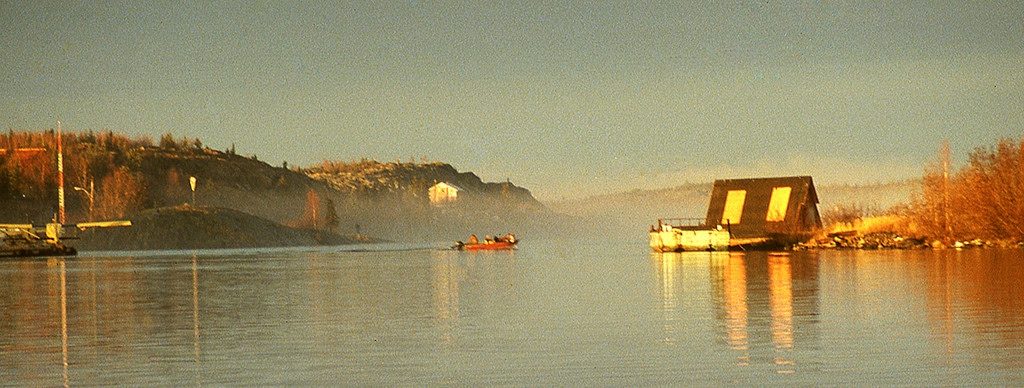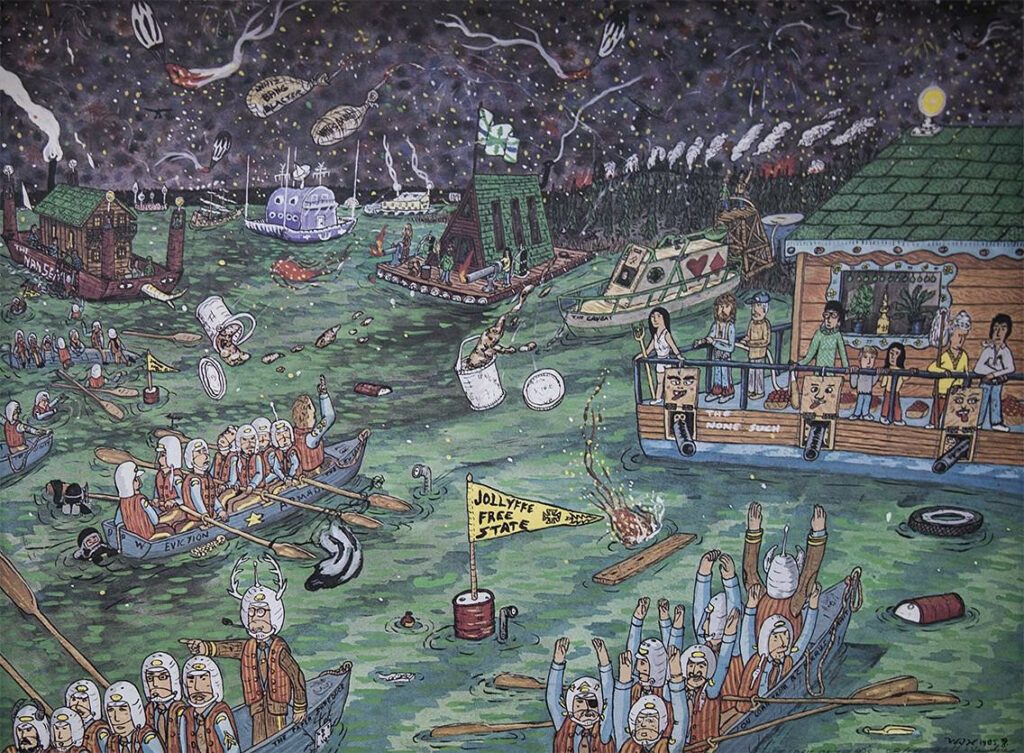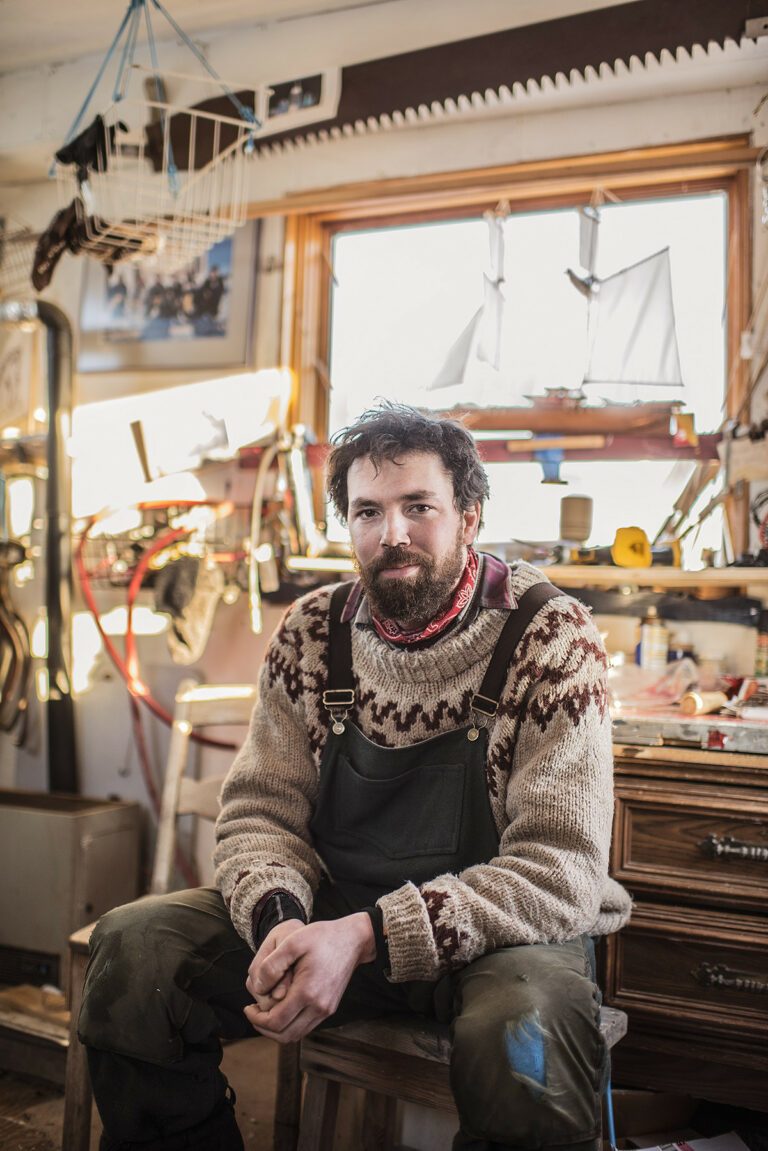When artist and former houseboater Brian MacDonald popped by the EDGE YK office with a heady claim – he and his A-frame houseboat were first on the lake – my interest was piqued.
Brian and I went for coffee and he regaled me with stories of the floating home and artist studio he built in 1981.
I drifted Brian’s claim by long-time houseboaters Gary Vaillancourt and John Alexander, and got a very different story. Tim Shandruk was first, they said, though they weren’t sure if his was a party barge or an actual home.
Needing a neutral voice, I turned to photographer and Old Town guru Fran Hurcomb.
As with any subculture, one should tread lightly when pressing origin claims.
Here’s what I came up with. If I’m off base, comments to mrendell@edgeyk.ca, rather than honeybuckets to the head, would be most appreciated.

Chris Holloway, Mark Scott and Dave Smith spend the evening together on Holloway’s houseboat in 1982. | photo Fran Hurcomb
Rumour places Yellowknife’s first houseboat on Fiddler’s Lake, out past the golf course. According to Brian, the houseboat appeared in the 1950s and belonged to a miner with a small claim on the lake. More than this remains uncertain.
The origins for big lake houseboats are less opaque – though there’s certainly controversy about who came first. Without wanting to start a war between old-timers, the best evidence seems to point to Tim Shandruk and his plywood barge shack.
In the summer of 1978, Tim bought a one-room shack that was sitting on a friend’s property in Willow Flats. He hauled it to the beach with a 4 x 4 and hoisted it onto the barge with a crane. The barge itself was an old plywood box filled with Styrofoam that was used to haul equipment to Bluefish Dam.
For the next three years it was the lone houseboat on the lake, spending most of the time moored to a half-sunken barge on the east side of Yellowknife Bay or puttering from anchorage to anchorage.
“It was not designed to last a long time as there was no wood preservative used and the deck was pretty rotten. It was difficult to tie anything to it, as it would just pull out. This caused a number of unplanned voyages over its life,” said Chris Holloway, who lived on the boat in the early ‘80’s, in a post on the YK Memories Facebook page.
The rotten wood welcomed a family of muskrats who tunneled through the hull and into the barge’s Styrofoam core.
It also led to the boat’s demise in 1988 when an August storm tore the cleats out of the deck, sending the boat across Jolliffe Bay and into the south shore of the island. You can still see bits of flotsam along the shore.

The A-Frame, 1985 | photo Fran Hurcomb
1981 – The A-Frame
After Tim’s shack, the next houseboat materialized in 1981. Brian was on the hunt for an artist’s studio and bought an old barge made of metal barrels.
“We had a blueprint to build a nice little boathouse, put in a 12-volt and everything,” said Brian. “Well we got back (after a day away from the barge) and Ted Mehler’s built this little A-Frame, little kid’s protractor. And so that’s how I ended up living in the A-Frame.”
Like Tim’s boat, the A-frame was mobile. It had an 8-horsepower engine attached to two cables that ran under the barge’s deck and connected to a steering wheel.
“I used to drive it around to Weavers to go get groceries,” said Brian. “The greatest thing was you could go to the government dock at the end of the day, fire it up and decide where you were going to spend the night.”
The summer of 1982, Brian loaded the barge with barrels of fuel and motored to the East Arm to hawk it to helicopter pilots. The whole cruise, the A-frame acted like a sail.
Like many future houseboats, Brian’s boat proved an ideal place to make art. Northern lights poured through two skylights in the slanted roof; there was a large table to lay canvases on or to make watercolour paper from cotton rags and old bed sheets.
When moored against Jolliffe Island, Brian could wander to the gravel platforms left over from Imperial Oil Tanks and practice mural painting on the wooden billboards still standing at the time.
After two years, Brian sold the boat and moved back to shore. “It really turned me off when anything that could move went into the water. It wasn’t an experiment anymore,” he said.
The boat was hauled out of the water in the ‘90s and became a shed across from government dock. Today, it lives in Kam Lake – though there’s rumour it’s heading back to Old Town.
1982-83 – Houseboats settle in
The first permanent houseboats arrived on the south side of Jolliffe Island in 1982 or ‘83. Gary and John, tired of living in the Woodyard, built two massive barges from 50-foot trees interlaced with telephone poles. Two hundred and seventy five 45-gallon gas barrels kept the barges afloat.
“In those days, aviation gas barrels, if they were dented, lost their deposit,” said Gary. “We used to go to all the aviation companies in town, the float bases, and whatnot, and take away the barrels they couldn’t get their deposits back on.”
The barges were built on the ice so when spring came they simply fell through and began to float.
“We went to a lot of trouble to find a place to put the houseboats. We thought of Giant Mine, we thought of Burwash, the shore on the other side of the bay. We even thought of Back Bay, though in the end we picked where we thought was the best.”
The wood for the houses came from an old Giant Mine bunkhouse that Gary and John tore down in 1981. What they built was a new breed of houseboat: multi-storey, multi-room, and replete with solar panels and water pumps.
“We had no idea what we started,” said John. “After us, there was a great string of boats, a couple a year, every year. Today there’s 45 or something.”
“At the beginning though – with the A-frame, Tim Shandruk, and us – it all came in this period of time where Yellowknife was kind of San Francisco North. The hippies had taken over in Old Town, and everyone was blossoming.”







